Search results
83 results found.
83 results found.
One of a couple of events which the organizers of Carnival have revived after rummaging around in Venetian history is a beauty pageant which is based on one of the more dramatic exploits in the city’s entire life story. And a beauty pageant.
It is called the festa delle Marie (ma-REE-eh), which is plural for Maria. There were 12, actually or temporarily named Maria, and what happened to them was not only an exciting demonstration of the fledgling republic’s developing power, but a great way to add a party to the calendar.

The story begins around the year 943, though documented accounts date from 1039. Some details remain open to scholarly debate, but the outline of the episode goes like this:
On the annual feast of the Madonna Candelora (February 2, also known as the feast of the Purification of the Blessed Virgin Mary), Venetians not only went to mass, they also organized an entertainment disguised as an act of municipal and Christian charity. Or vice versa. In any case, they were very good at this, I want to say without sarcasm — a skill that civic leaders today might consider acquiring.
Taking the established custom of blessing girls who were newlyweds on February 2, somebody thought it would be wonderful to choose 12 poor girls and include them in the event.
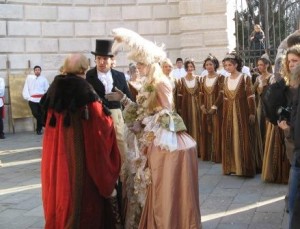
These twelve damsels had to be poor (otherwise the charitable part of the operation would be meaningless), obviously had to be engaged, and of course they had to be divinely beautiful — or at least more beautiful than any other poor engaged girl in their district.
The patrician families in their respective districts took up a collection to provide them with dowries; the doge lent them masses of jewelry of gold and precious stones from the state treasury, and they went in a procession of boats to the church of San Pietro di Castello, where they were blessed by the bishop in a sumptuous ceremony in the presence of the doge himself and all the noble families (on February 2, obviously).
The girls then resumed their procession, going to the Doge’s Palace (which it’s entirely possible they had never even seen; until recently, life here was generally limited to your own little neighborhood), where they were the centerpiece of a magnificent reception. Then everyone climbed aboard the Bucintoro, the doge’s ceremonial barge (in those early days it did not resemble the elaborate final version made famous in paintings by Canaletto, but still — the doge’s barge) and, followed by innumerable boats, went up the Grand Canal to the Rialto, then down the canal of the Fondaco dei Tedeschi to Santa Maria Formosa, where more solemn ceremonies awaited them in the church.
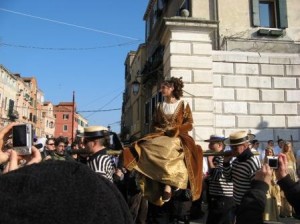
Things had gone along like this to general rejoicing until the year 943, when a crew of pirates — led by a certain Gaiolo, an Istrian pirate notorious for stealing Venetians and making slaves of them — burst into the church with his trusty marauders and made off with the girls. The Marias may have had a certain commercial value, but their jewelry must have been utterly amazing.
The doge — Pietro Candiani III — hastily organized a band of hardy men (I am not making this up) and they went racing off in hot pursuit, doge included. They caught up with the pirates near Caorle, slew them to a man, and carried home the brides (and their jewelry) in triumph.
If there had been a festa before, from this point it became ever more elaborate; not only to celebrate the 12 girls (as before), but now to commemorate the daring rescue of the 12 girls. Each February 2 the chosen girls were temporarily re-baptized with the name Maria, they were invited to all sorts of parties and receptions and balls and even mass in the major churches of the city. Venetians considered it good luck merely to be able to get near them. All this went on for nine days.
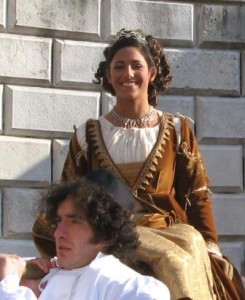 But it’s hard to keep anything up at that level of organization, cost, enthusiasm — whatever it is that makes festivals work. By 1272 the 12 girls had been cut back to four, then to three, because the cost had become annoying to the state as well as the noble families who were funding the event. There was also a big and expensive war going on with Genoa, the War of Chioggia. Can’t do everything. Can’t pay for everything, either.
But it’s hard to keep anything up at that level of organization, cost, enthusiasm — whatever it is that makes festivals work. By 1272 the 12 girls had been cut back to four, then to three, because the cost had become annoying to the state as well as the noble families who were funding the event. There was also a big and expensive war going on with Genoa, the War of Chioggia. Can’t do everything. Can’t pay for everything, either.
At that point somebody conveniently decided that it was wrong for people to have become fixated on this festival as a great way to ogle some beautiful babes when they should have been focusing on the religious aspect of the day.
So they eliminated the girls altogether and substituted figures made of wood — specifically, large slabs of wood cut out along the silhouette of a beautiful poor girl. Think paper dolls.
People hated it, and threw stones and vegetables at the wooden Marias when they passed. So the government passed a law, in 1349, forbidding the throwing of stones and vegetables at the wooden Marias. But the festa was obviously destined to die, and in 1379 it was suppressed altogether.

But not everywhere. The reviled wooden stand-ins, called “Marione de tola” in Venetian (big Marys made of planks), were taken up by the French in reduced form, and before you can say zut alors, they had become known as Marionets or petits Marions, and then marionette.
Now it’s Venice, February 7, 2010, and the Marias are back. For the past few years, part of the opening festivities of Carnival has been the Festa delle Marie, a procession of costumed re-enactors accompanying 12 beautiful girls which wends on foot from San Pietro di Castello to San Marco. The girls are chosen by a jury from many, many applications, and I doubt that they have to be either poor or engaged anymore. But they do need to be beautiful.
For a few years, back in the Nineties (I seem to recall 1996), there was another element: the Regata delle Marie. Rowing races were historically part of any important Venetian festivity, and this one was intended for pairs of women rowing mascaretas. The idea was that both women (or girls) had to be amateurs, rowers who had never participated in the official city races.
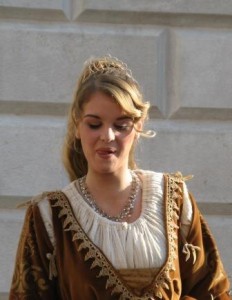 I joined in either the first or second edition, with an Argentinian girl named Magdalena. We were all nobodies; it was great. The starting line was just on the other side of the church of San Pietro, in the Canale delle Navi. We raced along somewhere toward Sant’ Erasmo — I wasn’t paying too much attention to the landmarks, especially after the purple boat veered across our bow and we kind of ran into it.
I joined in either the first or second edition, with an Argentinian girl named Magdalena. We were all nobodies; it was great. The starting line was just on the other side of the church of San Pietro, in the Canale delle Navi. We raced along somewhere toward Sant’ Erasmo — I wasn’t paying too much attention to the landmarks, especially after the purple boat veered across our bow and we kind of ran into it.
But we disentangled ourselves and rowed like Istrian pirates being pursued by an angry doge, and back up into the rio di Quintavalle to the finish line in front of the church. After all that, we actually came in fourth, which meant we won a pennant, which is all that matters. I also remember that experience because the second we crossed the finish line, Magdalena said, “I’m never racing again.” I never asked her why.
The race did well enough for a couple of years, then people began bending the rules into all kinds of weird shapes till the participants were basically the same people on the official roster. So the race, like the original festival, fizzled out, at least as part of Carnival. It’s now held in June, in honor of San Pietro. Nice thought, but nothing to do with pirates and doges.
 But back to Carnival. The procession of happy, heavily costumed Marias is fun, at least when the sun is shining. Where else can you dress up and be carried for a mile on a wooden platform by gondoliers while thousands of people take your picture?
But back to Carnival. The procession of happy, heavily costumed Marias is fun, at least when the sun is shining. Where else can you dress up and be carried for a mile on a wooden platform by gondoliers while thousands of people take your picture?
And it’s fun for the onlookers too, because — some things never change — they get to look at beautiful girls in fancy clothes.



I’m not a big fan of Carnival in Venice. The only bigness I can evince where this annual demolition derby is concerned is a jumbo-size package of the old Aristotelian pity and terror.
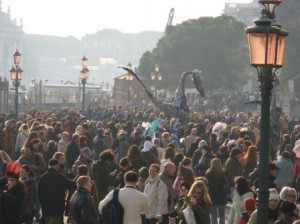
That’s not completely true: I don’t feel pity.
But this year I decided to take a different approach. When Carnival erupted last Sunday (after several premonitory tremors) I thought I’d imagine it was something that could be fun, amusing, diverting, worth the trip. Not for me — I’ve figured out how to make it fun for me but it doesn’t involve costumes or the Piazza San Marco — but just going with the idea that it could be entertaining for the thousands upon thousands of people who come to Venice expecting to enjoy themselves, at least, if not enjoy everybody else.
By which I mean, enjoy being squashed like a grape in a winepress by your fellow humans.
So far, it’s working. I had a fine time on Sunday afternoon. But that’s because I made a point of not going to the Piazza San Marco. The Gazzettino reported that some 90,000 people were there. They certainly didn’t need me, even if there had been room.
The first years I was here I did go, at least a few times, to the Piazza San Marco, the gravitational center of the festivities. It was all so new and strange, and memory reports that there weren’t quite so many thousands. Memory may be lying but it was fine anyway. Perhaps the novelty of the situation carried me over the crush, as it may well do to people today.

Then there was a hiatus, partly because I didn’t enjoy the winepress experience and also because what was going on there seemed strangely unfestive: Loads of people in costume (95 percent of which seemed to be identical), walking around just looking at each other, striking attitudes, or taking pictures of each other with or without tourists posing next to them. The nadir is occupied by the people in costume who charge money for allowing themselves to be photographed with your cousin or your kid. And they can make a bundle.
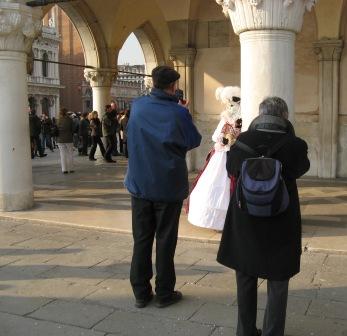


Then we came to Castello and I discovered something of the way Carnival was, decades ago, before the event was trampled by the tourism behemoth. Kids and families and dogs, and relatively few tourists. And did I mention the kids?
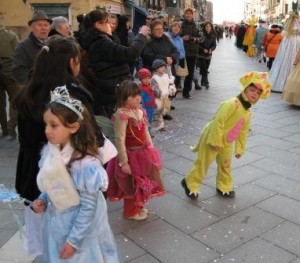
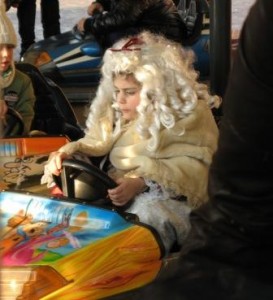
Perhaps I’m going senile, or perhaps it’s because the confetti-throwing and occasional Silly String-spraying and strolling around have no evident commercial focus, but I think the downtown version of Carnival beats San Marco in straight sets. Here, if you see somebody taking a picture of a person in costume, it’s almost certainly a besotted relative.
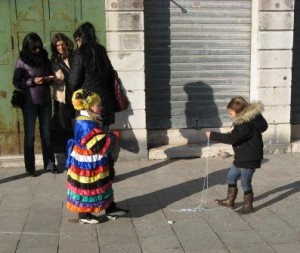
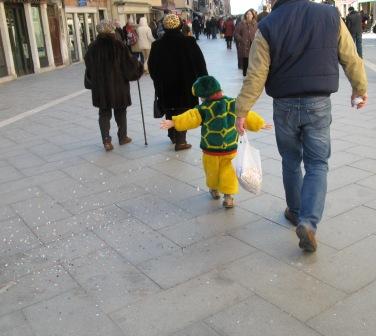
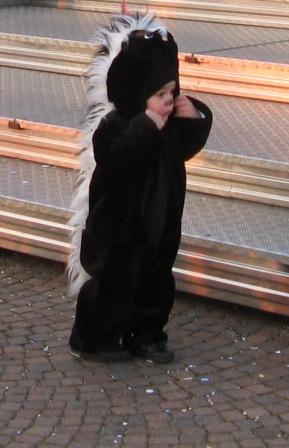

I
If you start to look around, you begin to notice how little it really takes to dress up and play Carnival. There were people who were looking great with only a hat, or a wig, or a moustache or whiskers scribbled on with a black marker– even the simplest mask imaginable just barely covering the eyes. No plumes, no sequins, no layers of painted papier-mache. It really works.
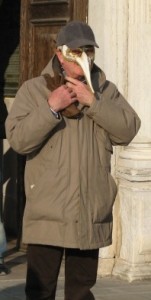
The first Sunday of Carnival (February 7 this year) was Opening Day, one of the maximum moments, as you can imagine. The others are Fat Thursday (Giovedi’ Grasso), and Fat Tuesday (Martedi’ Grasso). And the weekend between them. If the weather is beautiful — as it was on Sunday — it can feel like a party even if you don’t do anything special. If it’s really cold, overcast, windy or rainy, obviously the merriment becomes shredded and forced. This isn’t Rio.
Next chapter: I’ll be tossing out a few festive fistfuls of history, gathered from a large bag of brightly-colored bits of trivia.
Here’s a sample. “Confetti” here refers to the sugared almonds which are given to wedding guests. What speakers of English (and French, German, Spanish, Swedish and Dutch) call confetti — brightly-colored bits of paper — here are called coriandoli (ko-ree-AN-dolee). Why?
Because back in the Olden Days, Carnival revelers would toss all sorts of things around or at or on each other — eggs full of rosewater was one hugely amusing toy to everybody except the women who were on the receiving end. People would also toss various tiny edibles, particularly coriander seeds, which were used in pastries. Then they became bits of sugar pretending to be coriander seeds. Only much later — in 1875 — did flakes of paper begin to be used instead, which is an entirely different story. People who had always called the flying fragments of food “coriandoli” merely transferred to term to the newer-fangled form.
Generations have made their fortunes, to one degree or another, promoting Venice as a city of mystery, secrets, enigmas. What amazes me, though, is how many discoveries one can make by just looking around. It’s not as if you have to go looking for secrets — there are plenty of extraordinary things sitting right out there in the open, in front of everybody, but that go unnoticed for ages.
I have walked with Venetians, on our way to do something, who have suddenly stopped, looked up at/around/behind/next to some normal thing (a bridge, a window, a door) at something strange or beautiful and said, “I never saw that before.”
So here is something I saw because I looked up. Was it a secret? Only from me until that afternoon.
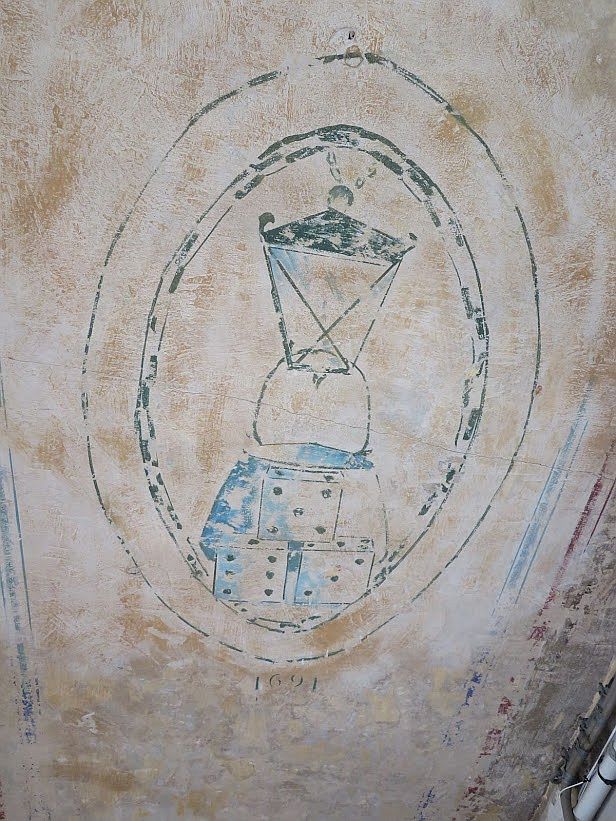
This fresco isn’t far from San Marco at the intersection of the Rio Tera’ de le Colone and Calle dei Fabbri. Here is a map to clarify.

Looking up as I walked west along the columned walkway …
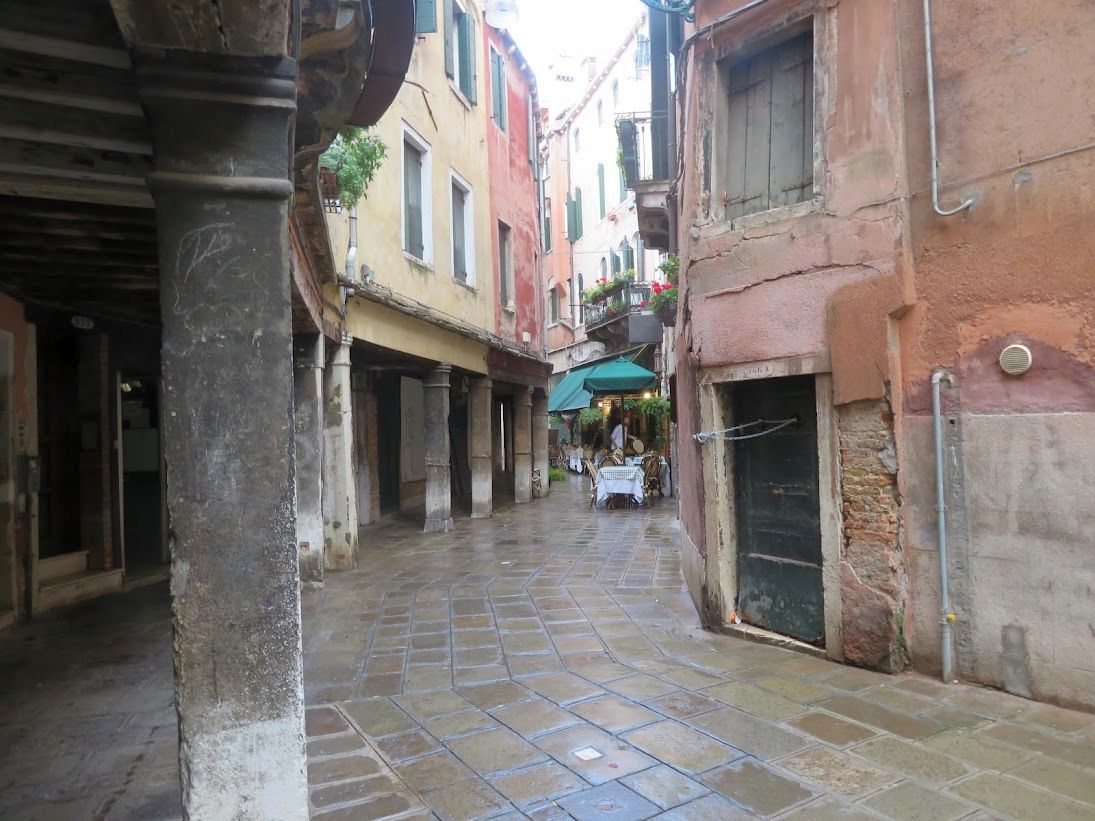
I came upon this, as previously noted:
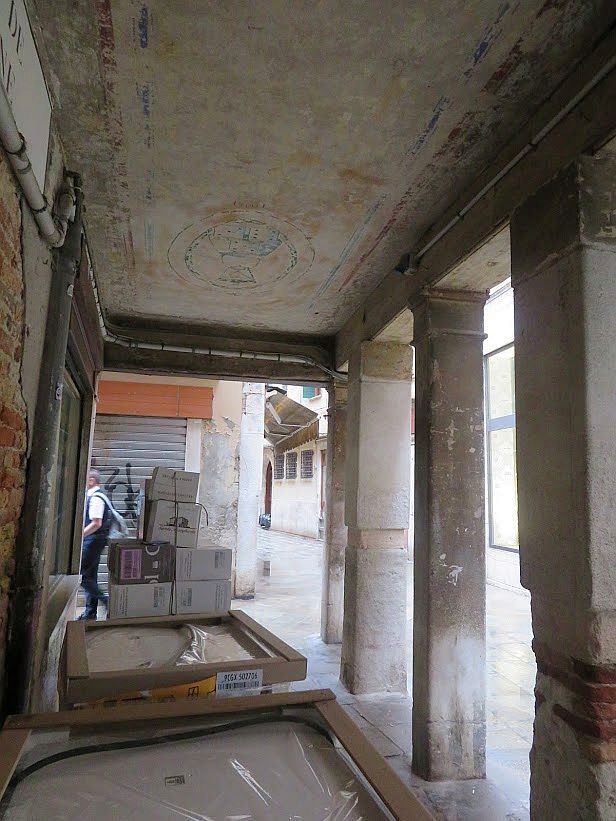

Back to the fresco at hand. My first theory was wrong, of course, but I wasn’t alone in supposing the dice in this design to be a mystic reminder of what may have been a gambling establishment back in 1691. There were plenty of them, but people probably didn’t need signs to show them where to go, mainly because gambling was mostly illegal.
Rummaging through the internet I found that several people had also found it reasonable to suppose that gambling inspired this curious fresco. But then I was even more surprised to discover a much simpler explanation. No need to go any further back than the 1980s and a particularly whimsical artist named Dorino Cioffi (born 1932 in Este, Veneto region), now living and working in Venice.
I could go find him and ask him about all this, and I’m not saying I won’t, but I wanted to get this little tale out into the ether. Whatever his motivations might have been, and however he may have managed to get permission to paint on a public space (“No worries, it’ll be down by Wednesday”), he created this diverting little image. Fooling people is so much fun. Carnival comes to mind.

For reasons as yet, if ever, to be discovered, the artist devised this image to refer to the three bridges nearest to the location of the fresco. I don’t know why that spot was chosen, though if you’ve decided you want to paint on an outdoor ceiling, your options are already limited.
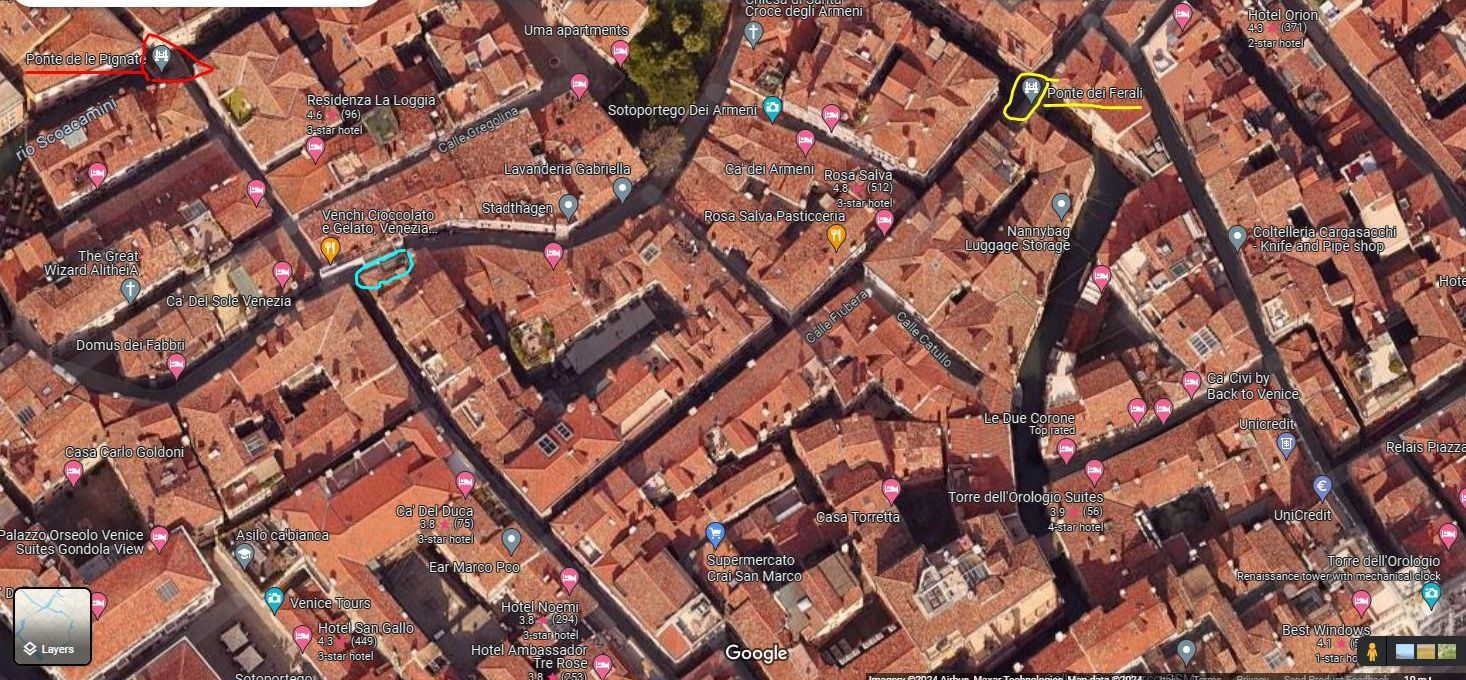
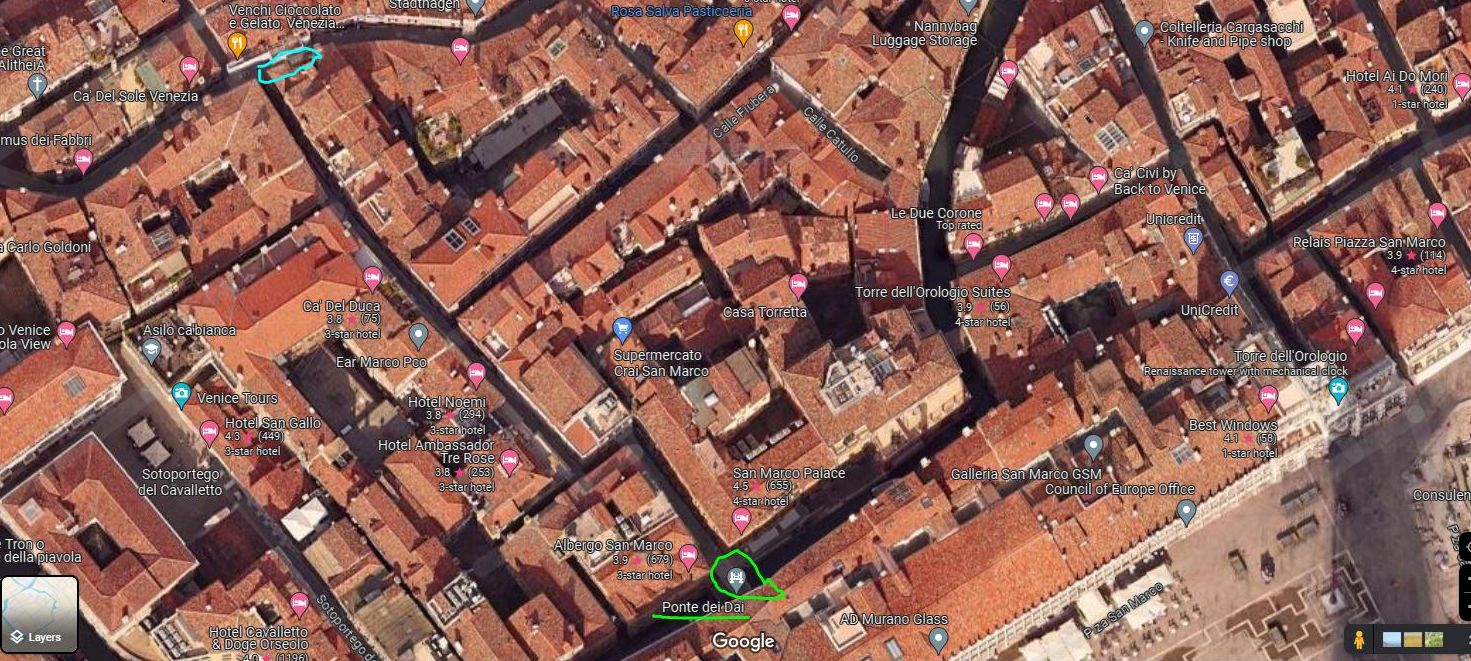
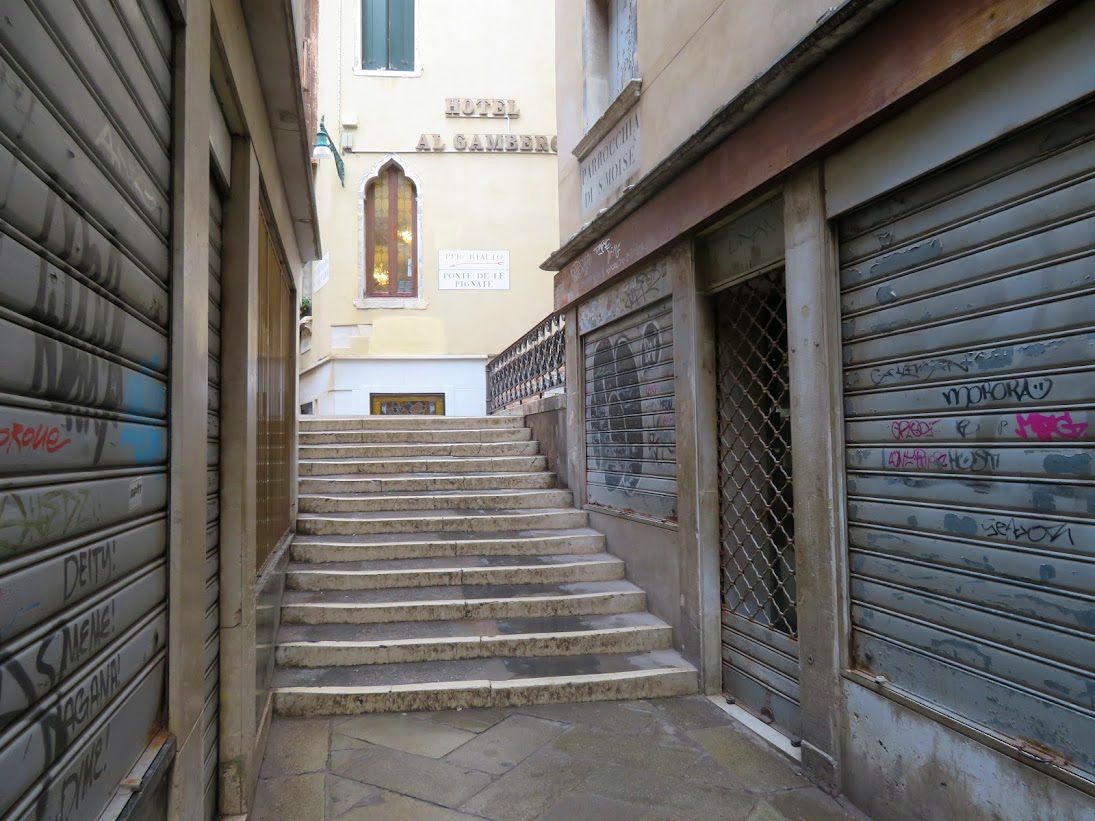
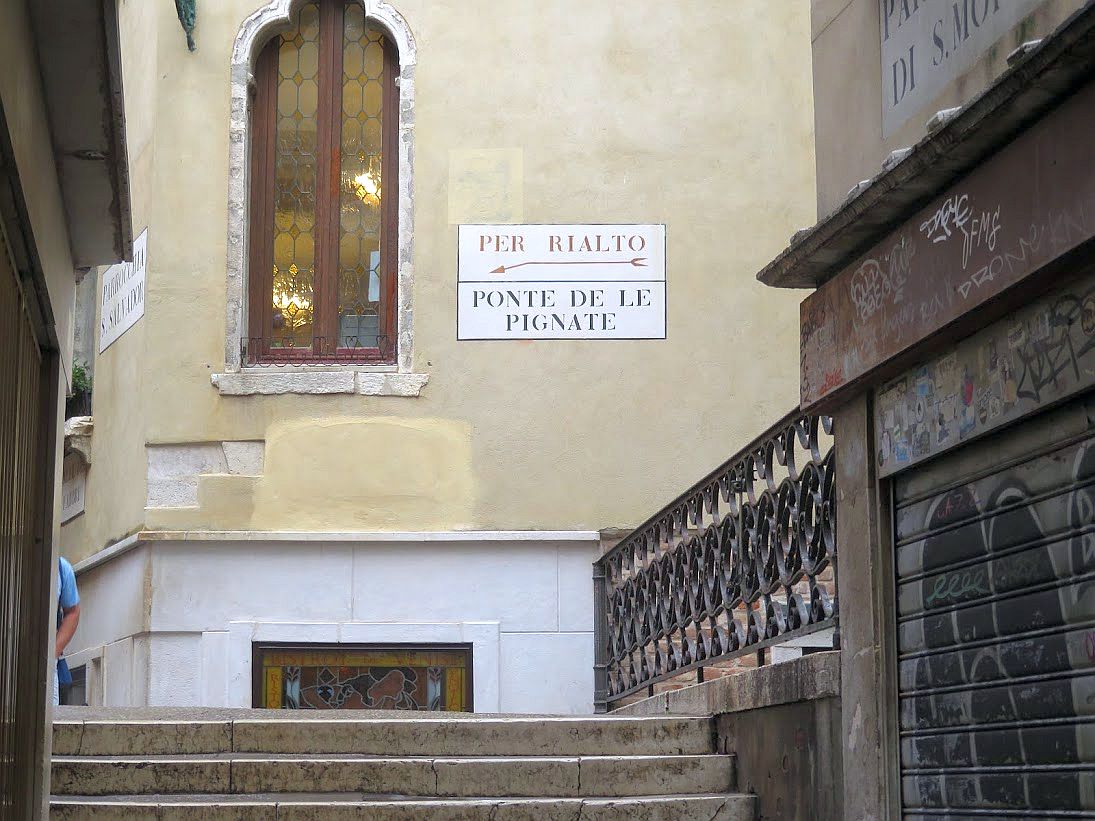
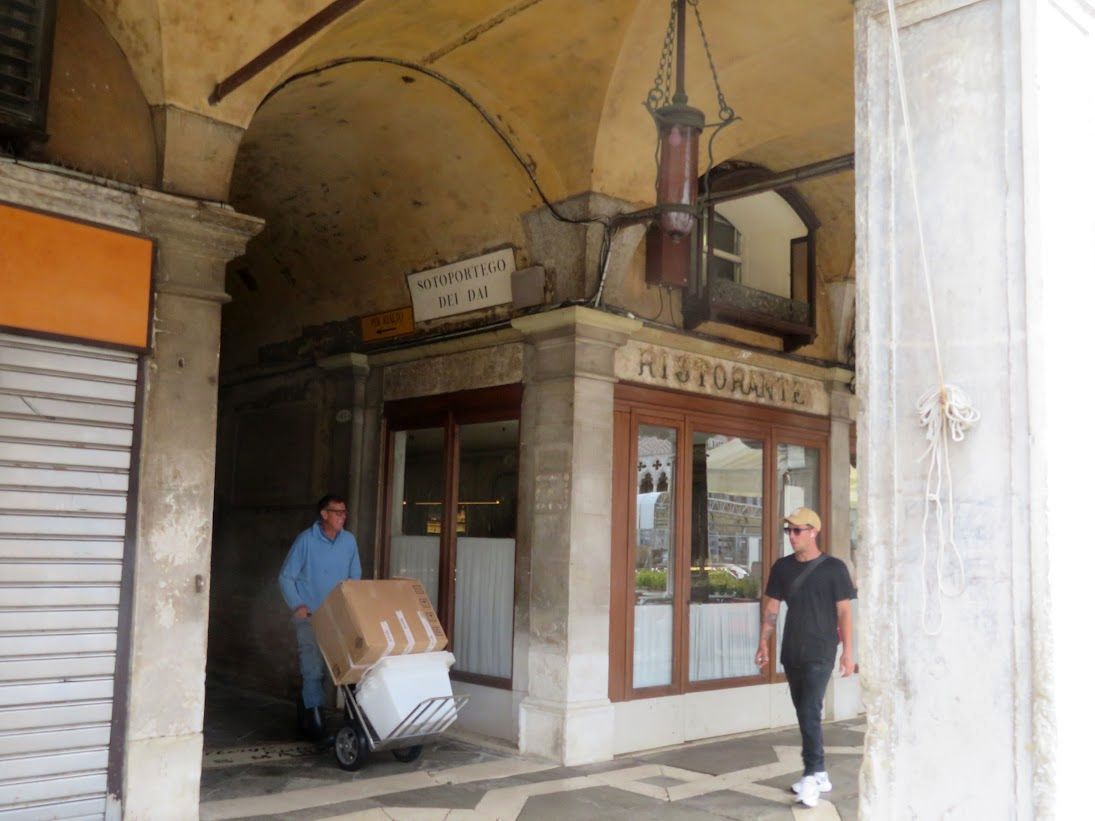

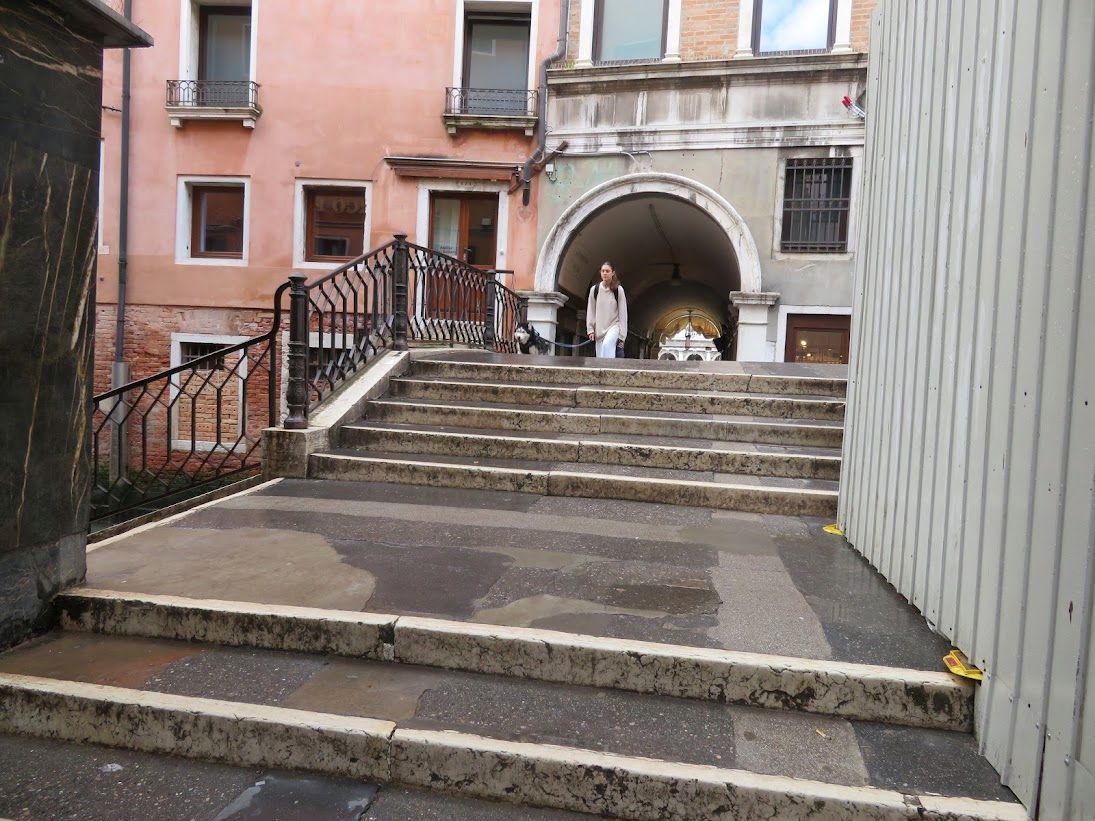

The names of the bridges, like the streets, referred to something that was made, or sold, or both, on or near that bridge. As far back as the 1200’s the feraleri, or makers of streetlights (ferali), had set up their shops on nearby streets, as well as on the bridge itself (do not ask me how that worked). The same explanation applies to the pignate (cooking pots).
As for the dai (the original name was dadi, or dice), they were not so much produced as simply sold near their eponymous bridge. This is amusing, considering that gambling with dice was forbidden. You and your friends might call a place the “bridge of crack cocaine” if that’s what makes sense to you, but painting the name on an official street sign would be strange. I think we can agree on that?
You may be awaiting more information on the pots and the dice, which I suppose there is, but the streetlights turn out to be far more interesting than the other two items put together. (Do not recommend.) As I leave the eccentric fresco behind, though, I can say that without it I almost certainly wouldn’t have given a thought to the lamps.
My next post will be shedding plenty of light on the subject.
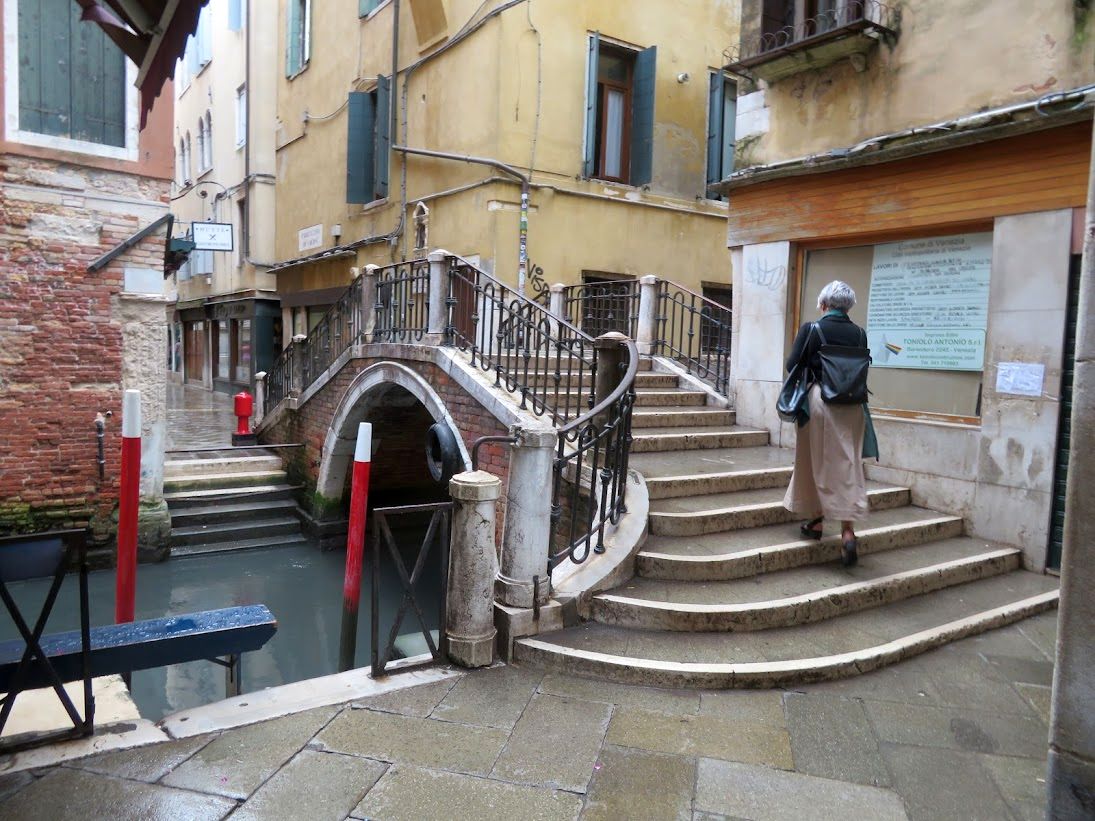
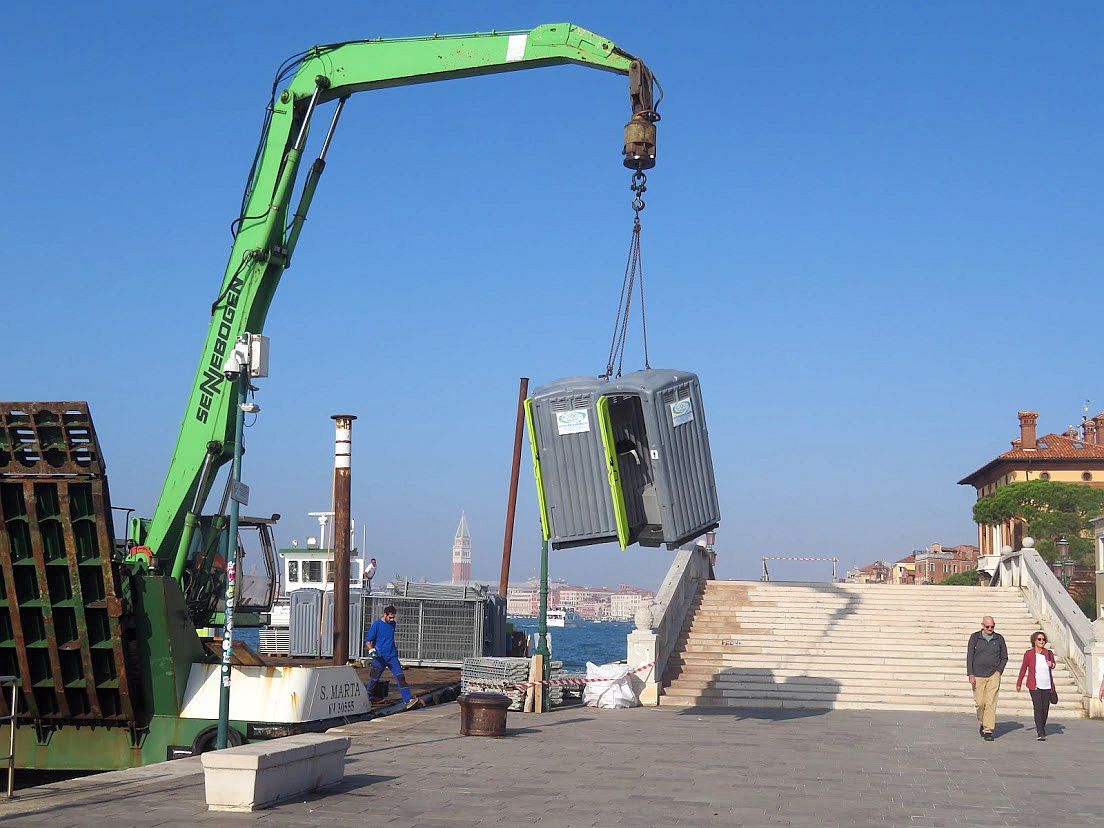
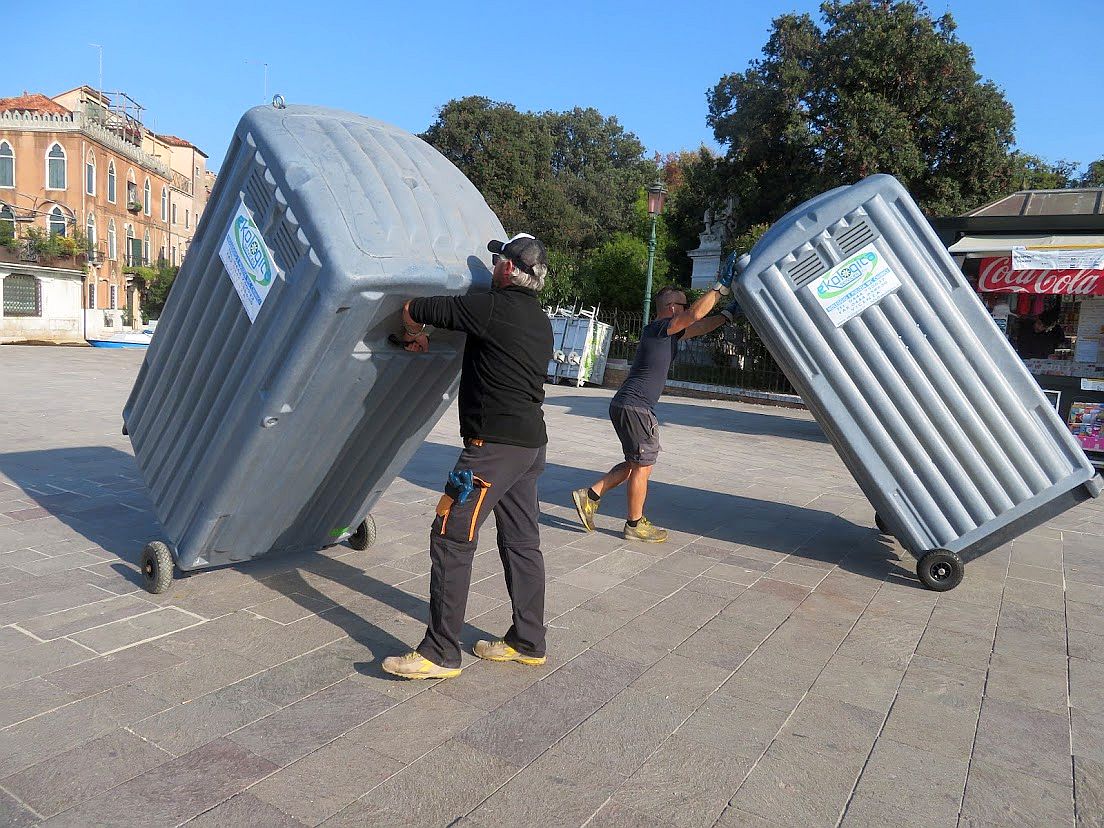
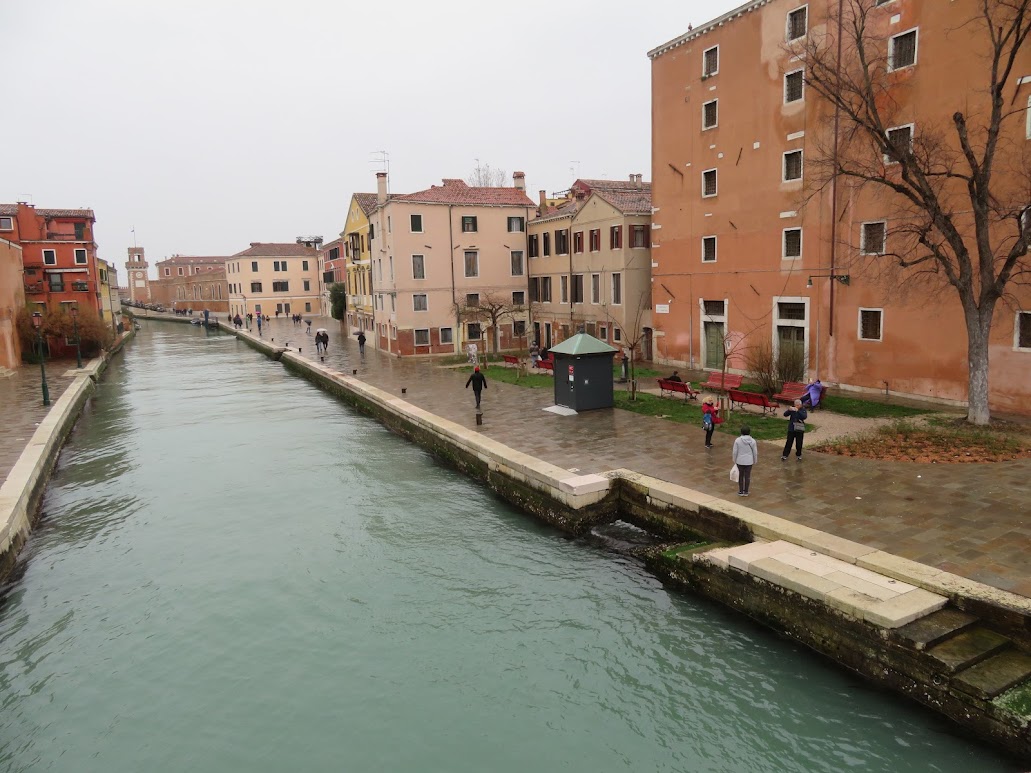
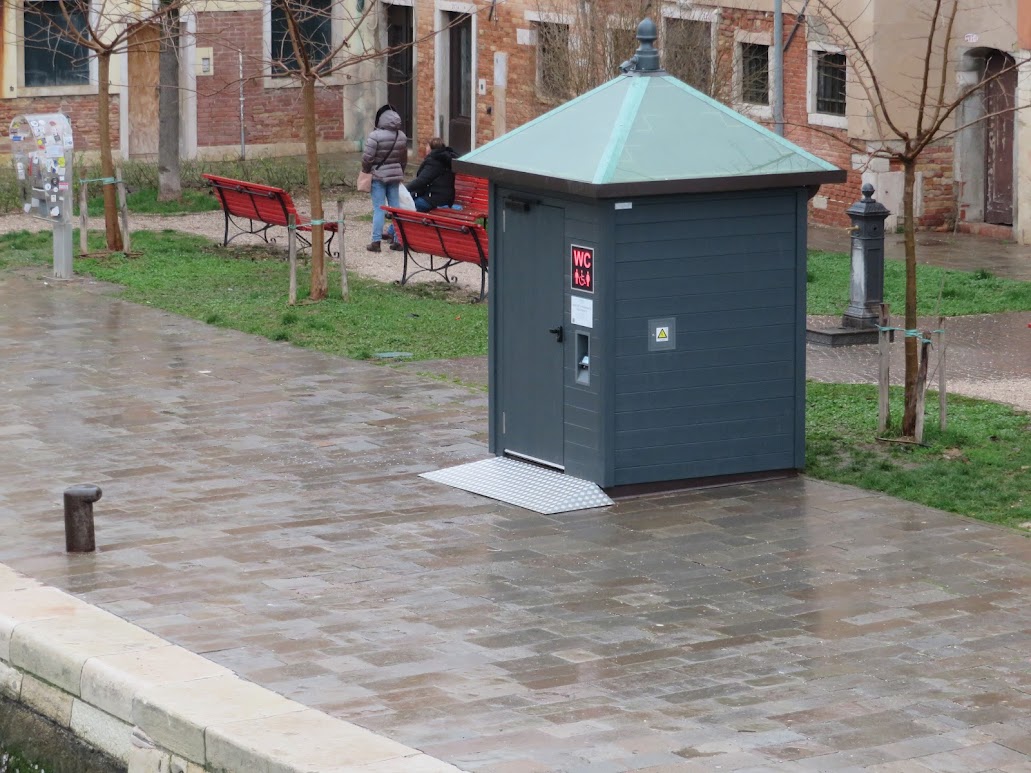
This is a simple tale composed of two parts. (A) What we need and (B) how hard it can be to obtain it because of (C) (my error, the tale has three parts) other people. To demonstrate I take the situation of the new experimental temporary chemical toilet (A) near the Arsenal and (C) the city of Venice, some city councillors of.
People need places to relieve themselves, we’ll start there. On the whole, visitors manage the situation by stopping at bars/cafe’s, buying something, and using the facilities. But sometimes bars/cafe’s are closed. Sometimes they are crowded. Sometimes the WC is mysteriously out of service. And sometimes the owners have to crack down on tourists who show up in groups of which one person buys a coffee and all the rest use the bathroom, as we call it in the US. Not made up. So one person is relieved, so to speak, and his or her nine friends have to start looking for a toilet somewhere else, or buy a coffee, which is clearly something they were hoping to avoid.
Impatient and drunk males at big gatherings at night have no problem at all: Find the nearest wall. Vertical structures exert an atavistic allure to men. Ladies, you’re on your own, as usual. But there are small side streets — I’m thinking of offshoots of Campo Santa Margherita — whose residents have been driven to install a gate to prevent revelers from using the street to resolve the situation.
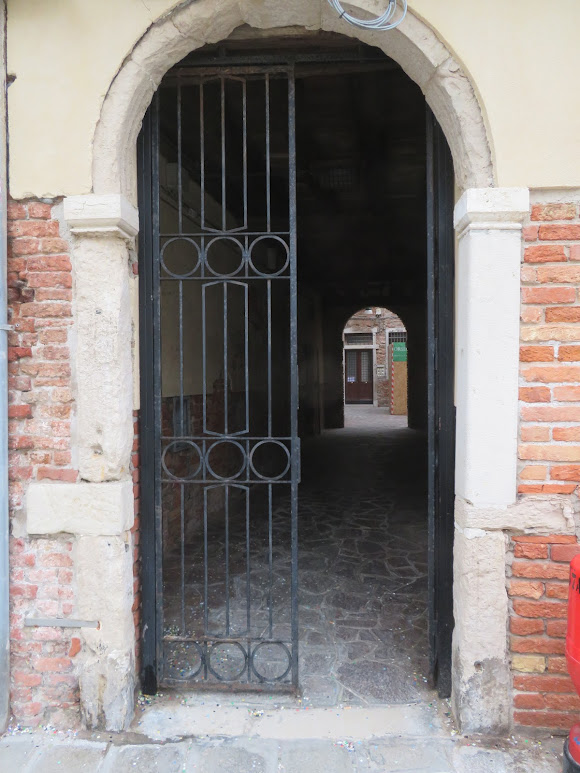

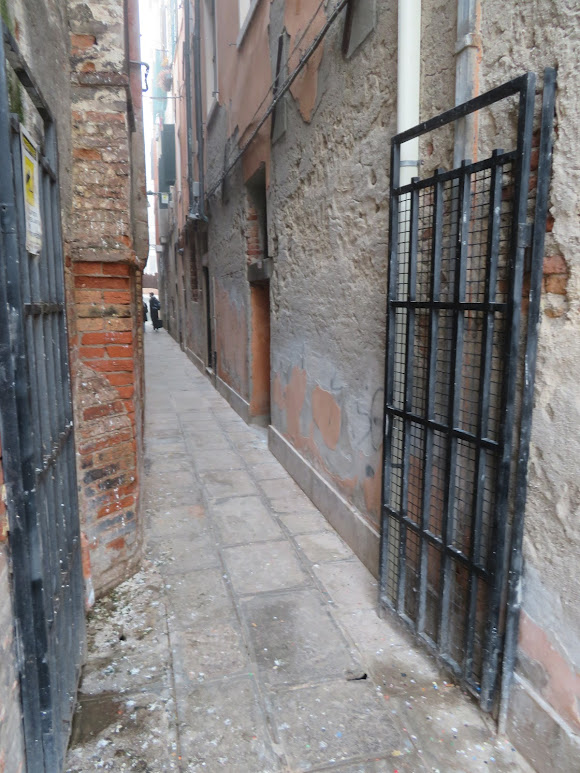
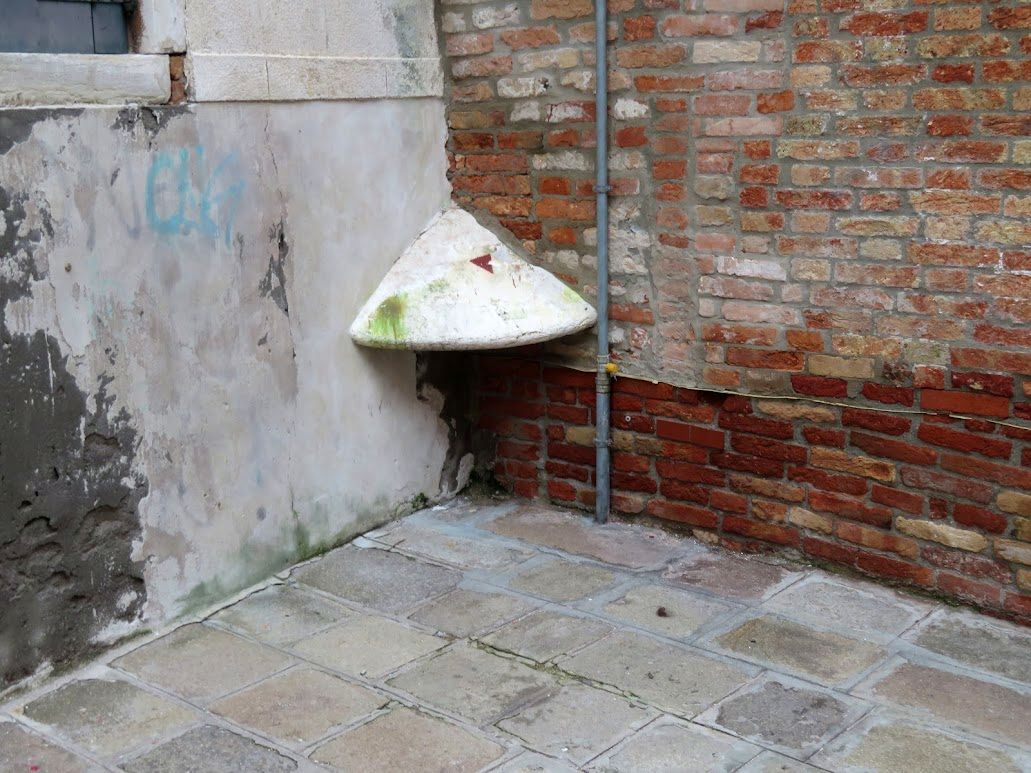

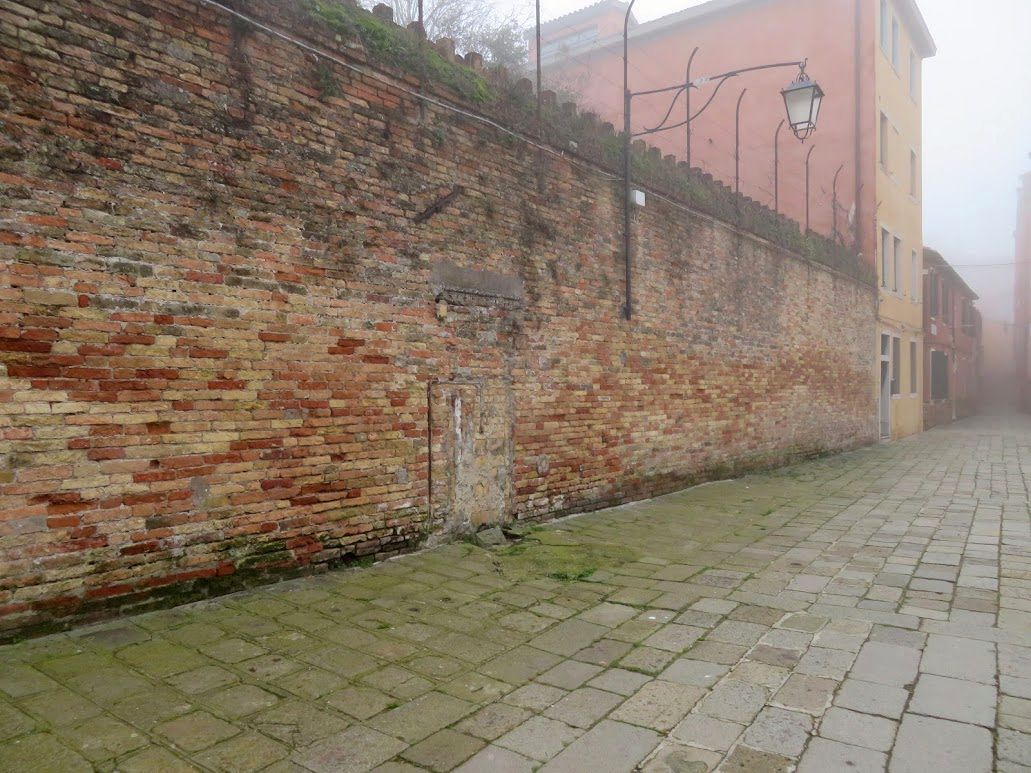


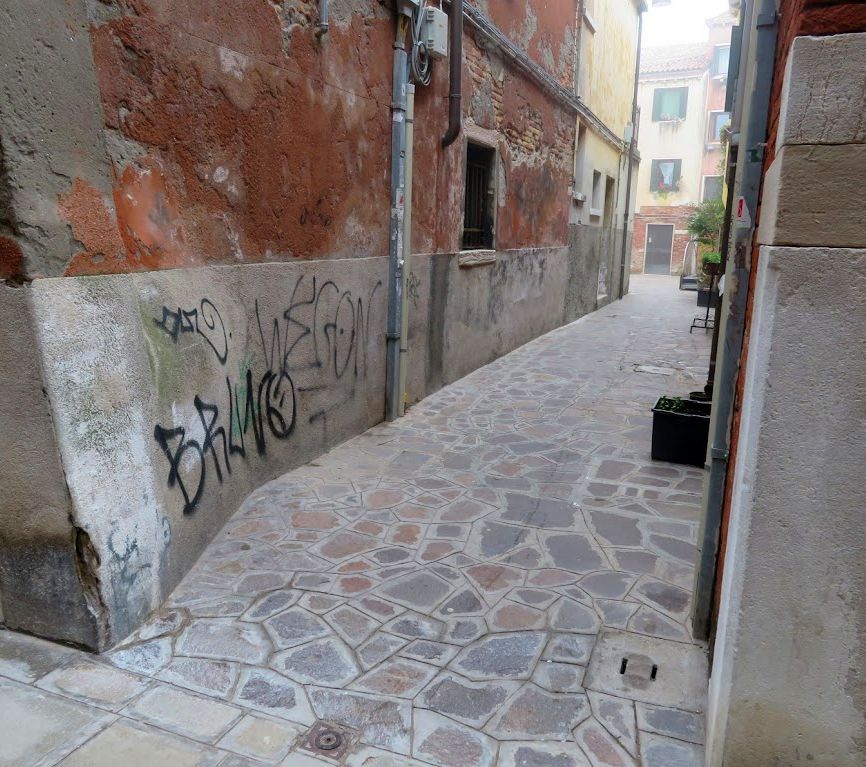
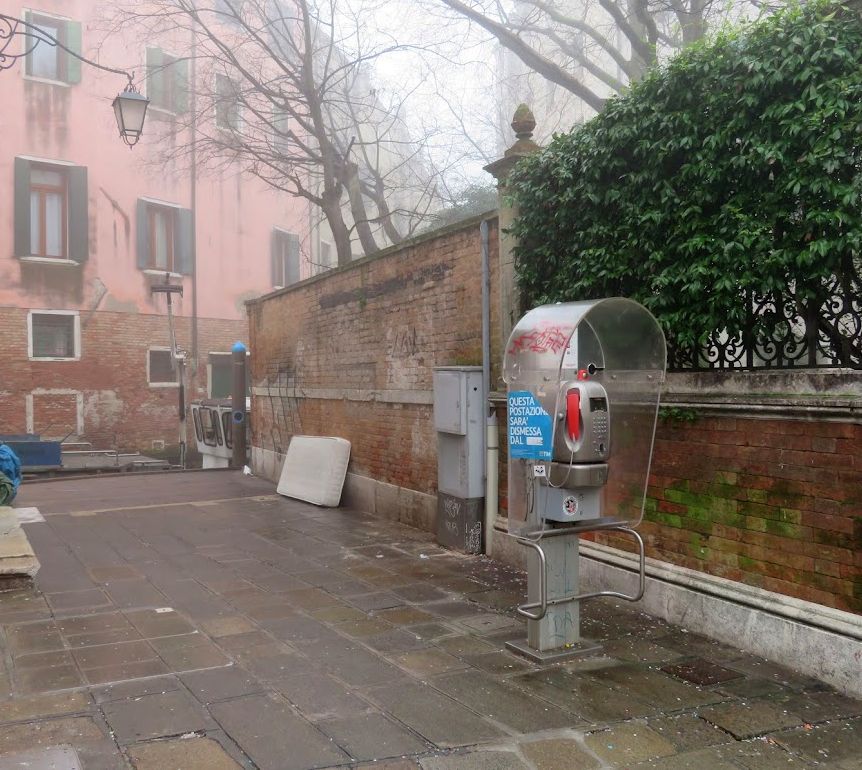

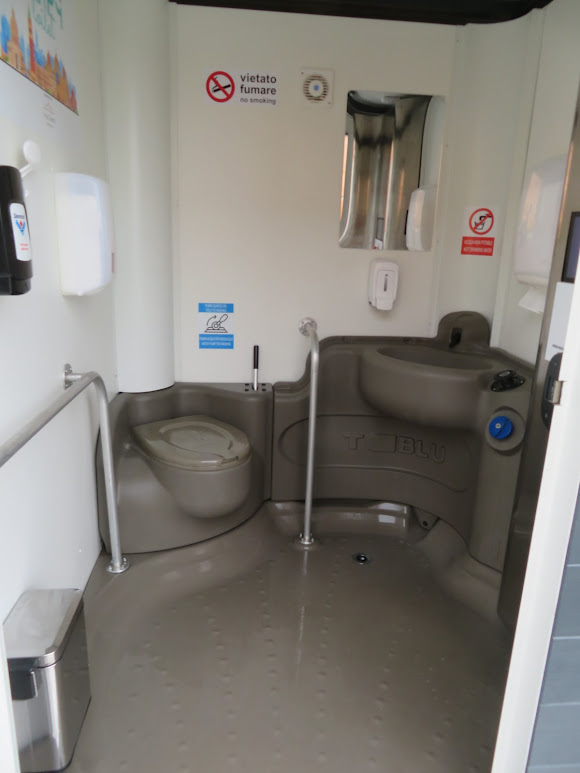
But the choice is not kiosks or nothing. There are permanent public loos in Venice. But there aren’t very many, their hours vary WIDELY — 8:00 AM to 8:30 PM is rational, so is 9:00 AM to 9:00 PM, but 11:00 AM to 4:30 PM or 10 AM – 7:30 PM is not. And they aren’t always open. The WC by the Piazza San Marco is scheduled to open at 9:30 AM, and when I passed by at a very reasonable 10:45 AM it was shut up tight. These hours undoubtedly reflect the convenience of the staff, and not the public. Or whether the Comune has paid the water bill?
In an attractive gesture of collaboration, the city has an app to guide you to the nearest public toilet. Perhaps it will be open, perhaps not, but at least you can say you found it.

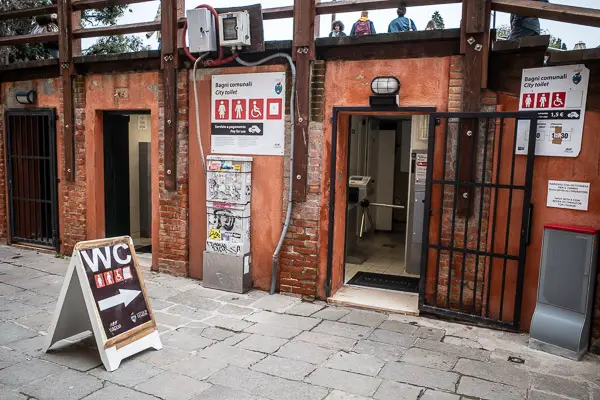
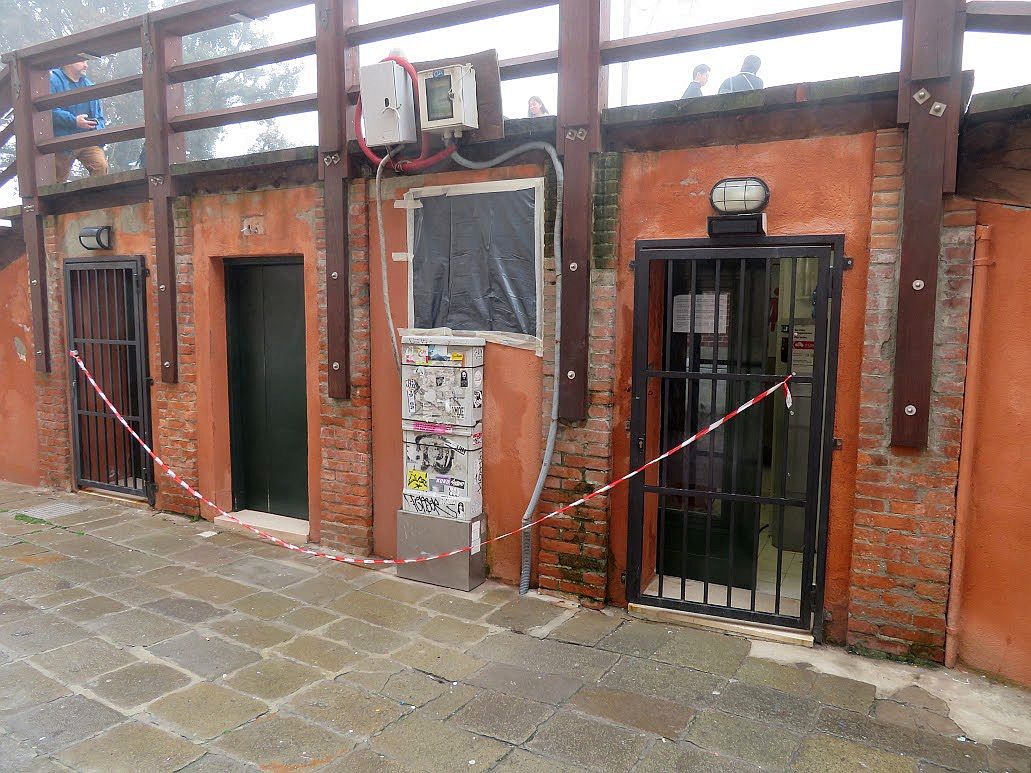

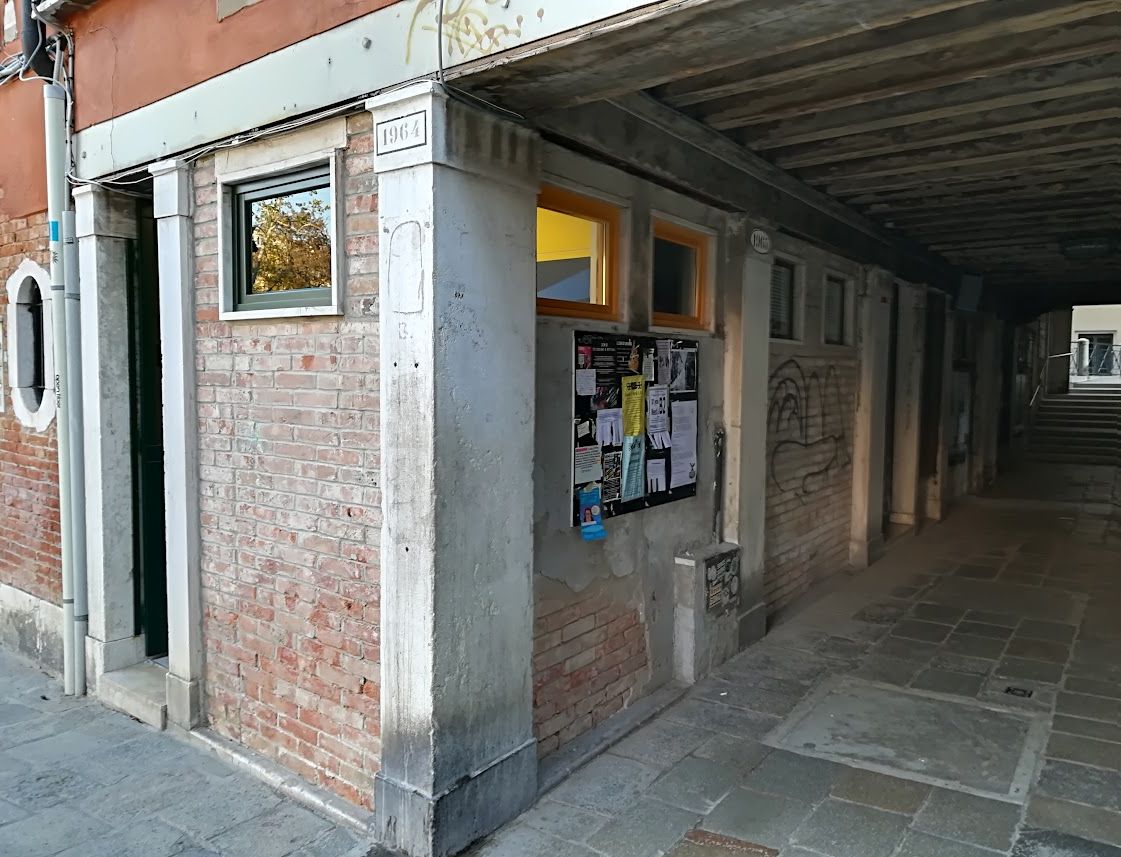
I decided to experiment and went looking for one of the city’s toilets last Saturday afternoon around 5:00 PM. I was near the Arsenal, and wondered where the large sign indicating a nearby loo might lead me. I didn’t need it, and what a good thing that turned out to be.
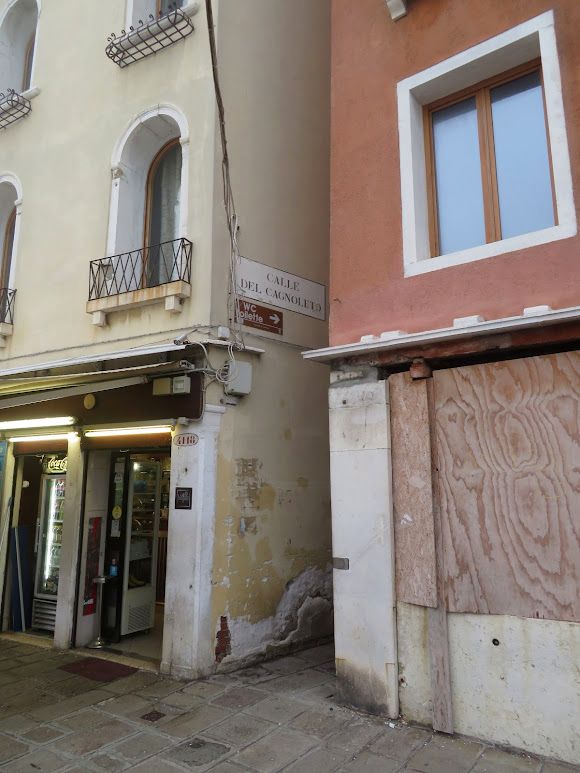

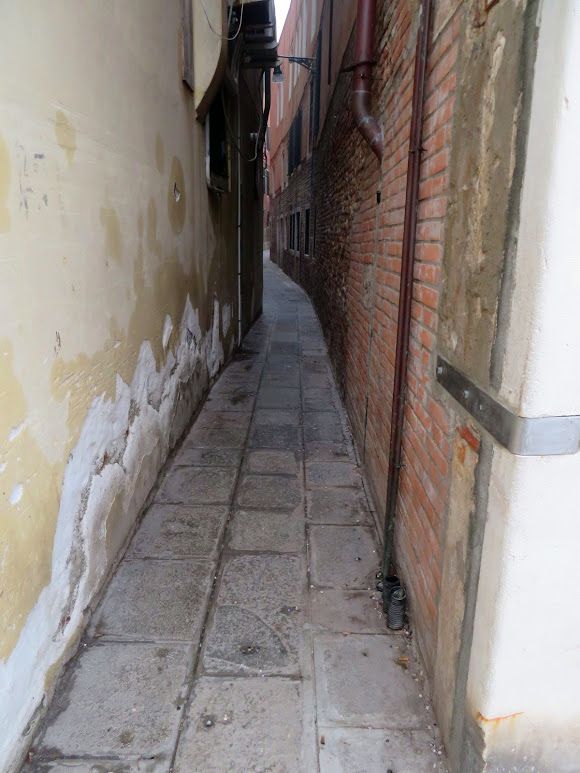
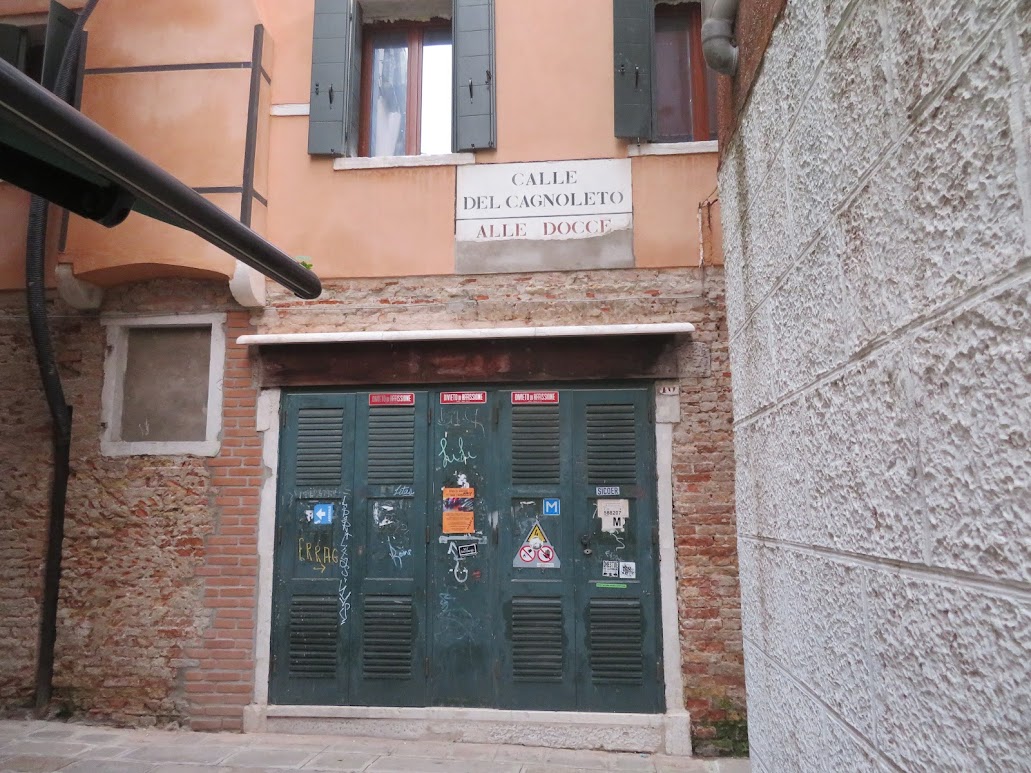

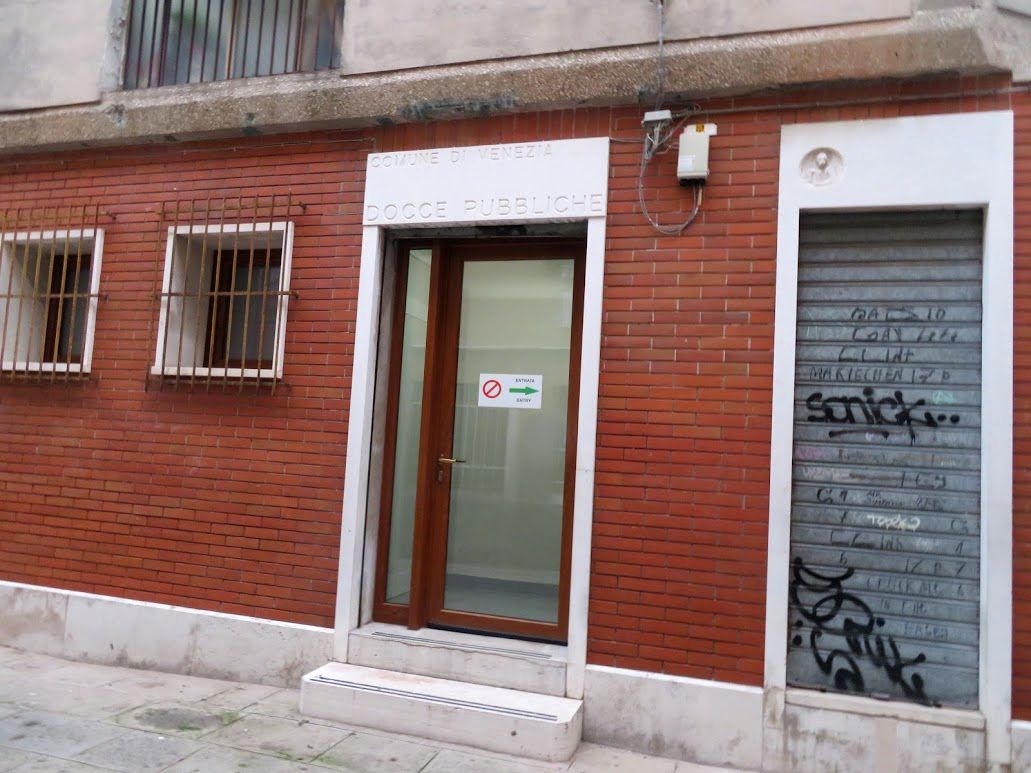
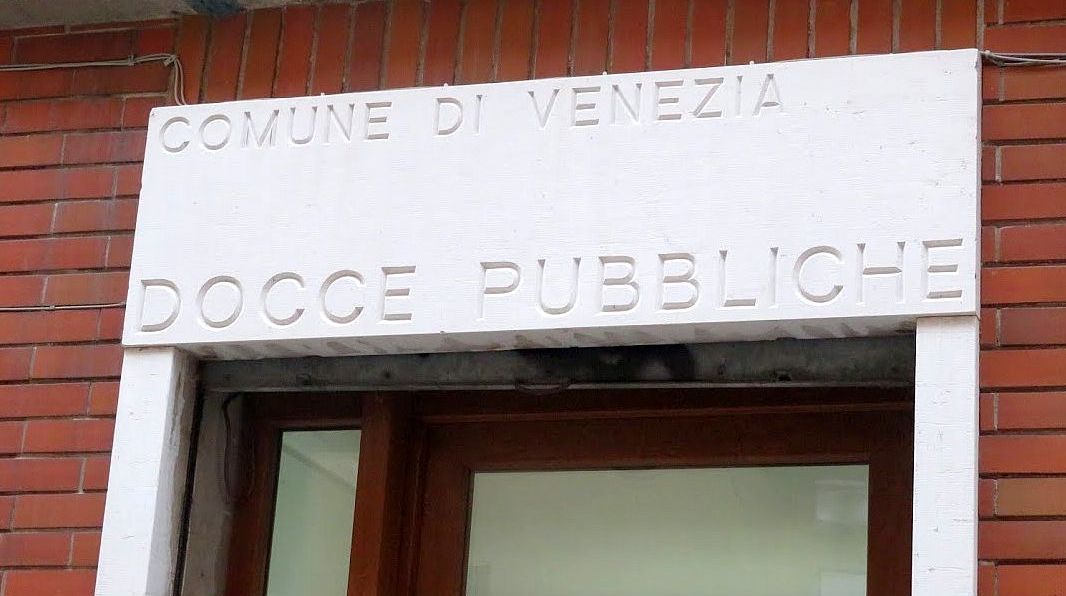
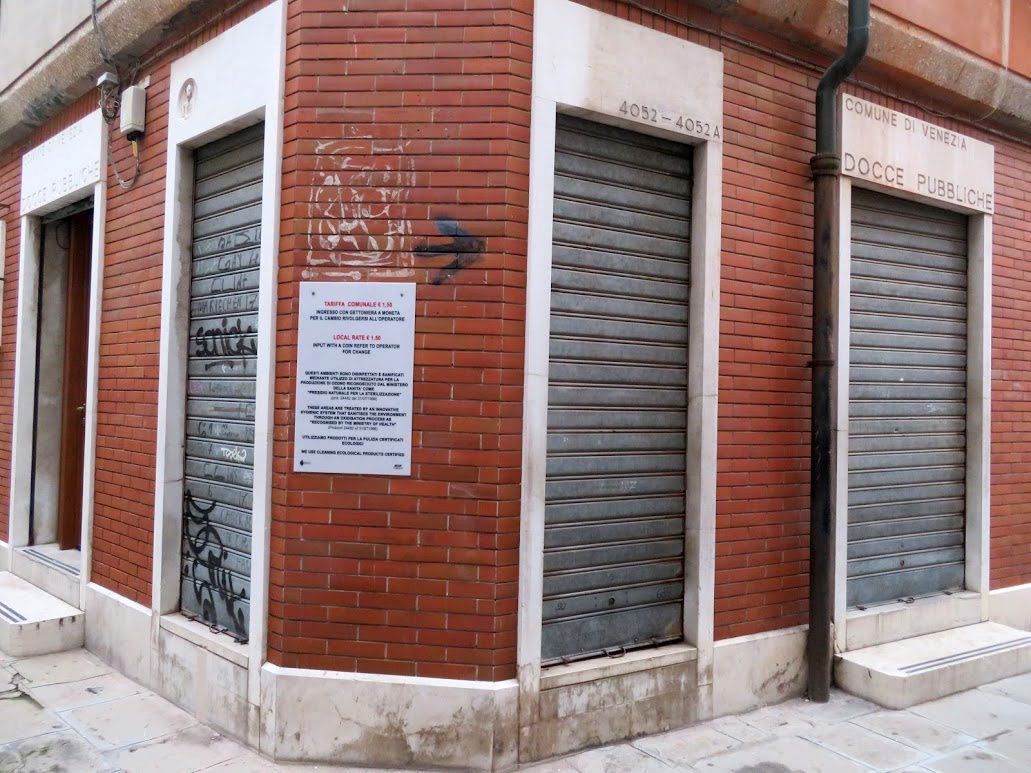
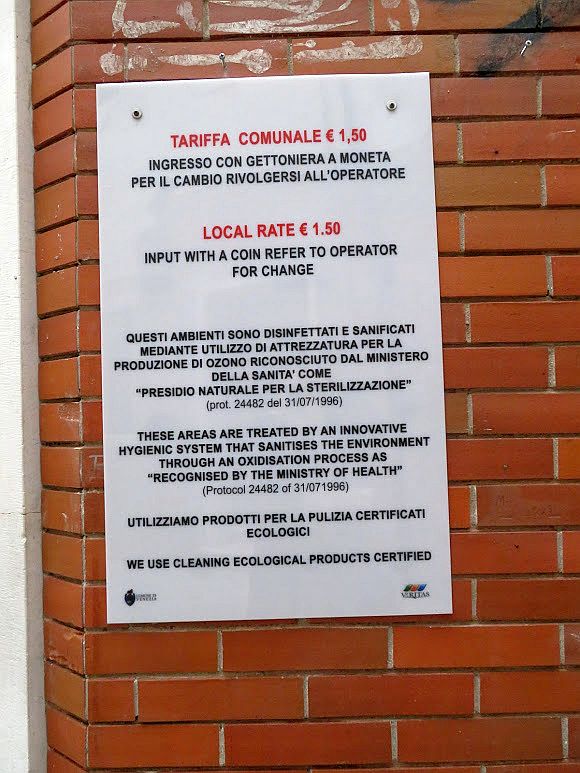
So to review: The options for needy travelers are: Resort to one of the numberless bars/cafes, when available either geographically or according to time of day; or public toilet, when available either geographically or according to time of day. Or wall. Or canal.
Let’s return to the kiosk. 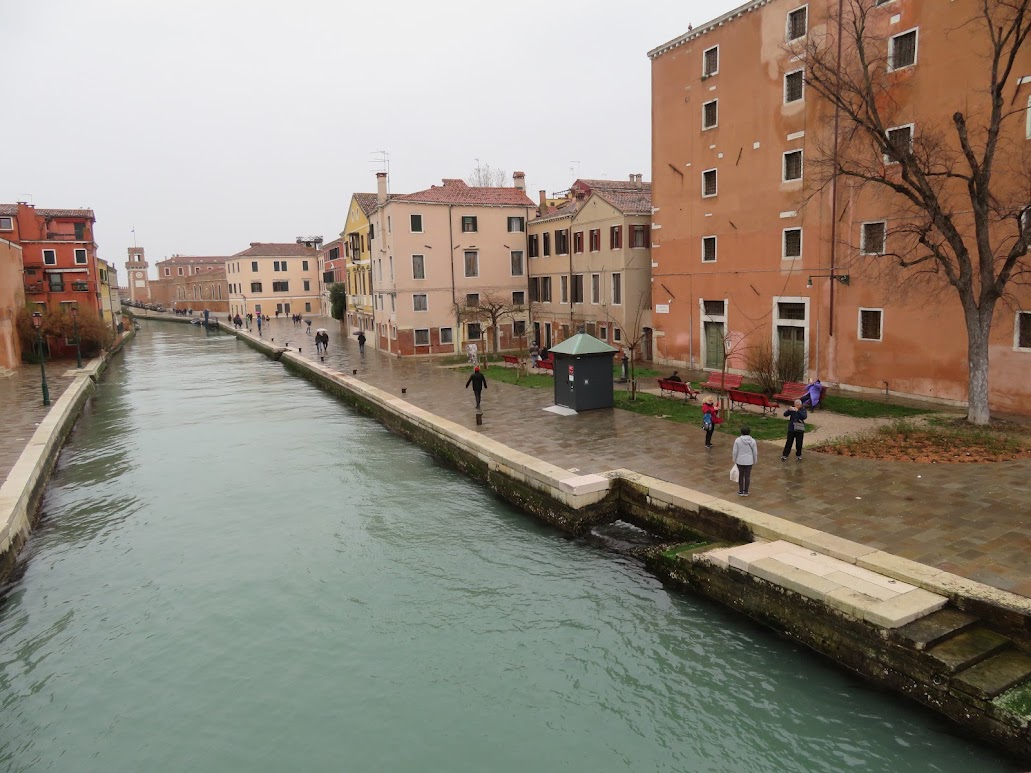 The Comune opened the public-toilet project for bids in 2019, with a budget of 5 million euros, and only one company submitted a proposal. Hygien Venezia was prepared to proceed, then the pandemic intervened. So now, three years later, the company has finally installed its creation for a two-week trial. Then all the reports and analyses and opinions and pros and cons will be thrown into a box and shaken (I’m making that up), and some decision will be made on installing the 20 more that the company is ready to place strategically around town.
The Comune opened the public-toilet project for bids in 2019, with a budget of 5 million euros, and only one company submitted a proposal. Hygien Venezia was prepared to proceed, then the pandemic intervened. So now, three years later, the company has finally installed its creation for a two-week trial. Then all the reports and analyses and opinions and pros and cons will be thrown into a box and shaken (I’m making that up), and some decision will be made on installing the 20 more that the company is ready to place strategically around town.
Don’t assume that decision will inevitably be in the positive. This being Venice, some people have complained. From shops and hotels and other enterprises, some people have objected. The Nuova Venezia only referred to the protesters as “the categories.” What category? The Worshipful Company of Environmental Cleaners? (It exists, but not in Italy.)
Whatever the “categories” might be, eight city councilors have spoken up, expressing a desire to inquire of the mayor “on the basis of what information is it considered that Venice possessed the characteristics to manage the cleaning (removal of waste) of 28 chemical toilets.” It occurs to me that Hygien Venezia probably has foreseen the problem and the solution, and described the plan on the bid itself. I’ll bet that they will be able to provide answers as needed, without bothering the mayor.
Perhaps the NIMBY (Not In My Back Yard) phenomenon has arrived in Venice. There may well be those who do not wish to see one of these kiosks near their homes or places of business. I will grant you that the general lack of space here means that there is a risk that a new structure, however modest, could make the immediate area even more crowded. However, there are also campos and fondamentas that can boast of space. But let’s not quibble. Essentially, there seems to be an innate propensity to assume something new won’t work rather than consider ways in which in might perhaps be configured to work.

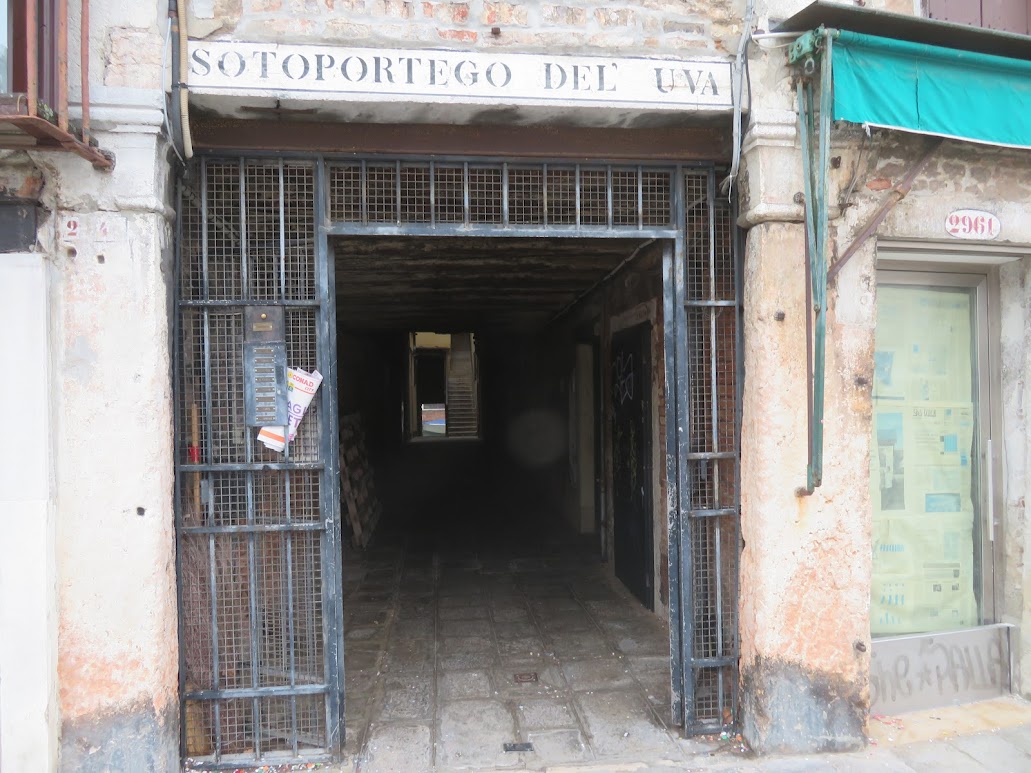
In my view, this is another of the many situations in which Venice’s perplexity as to how to manage the city comes to the fore. Lots of real cities have public toilets in the streets. Paris comes to mind, obviously — if there’s a city with bars/cafe’s at every turn, that would be Paris, and yet there are 420 cubicles on the streets of the City of Light, used 3 million times a year. I grant that Parisian streets tend to be more spacious than your average calle. But the port of Piraeus has concise public toilets, as do Madrid, and Oslo, and Berlin, and so on. Or at the very least, reorganize the public toilets in Venice with rational hours and doors that can be opened.
“The categories” want tourists, and then people grumble at how demanding those tourists can be. It seems to me that Venice might occasionally consider dismounting from its high horse on certain issues. Give the horse a rest.